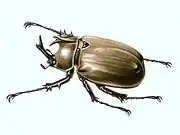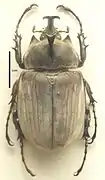| Megasoma anubis | |
|---|---|
 | |
| Male of Megasoma anubis from Brazil | |
| Scientific classification | |
| Domain: | Eukaryota |
| Kingdom: | Animalia |
| Phylum: | Arthropoda |
| Class: | Insecta |
| Order: | Coleoptera |
| Family: | Scarabaeidae |
| Genus: | Megasoma |
| Species: | M. anubis |
| Binomial name | |
| Megasoma anubis (Chevrolat, 1836) | |
| Synonyms | |
| |
Megasoma anubis is a species of beetles belonging to the family Scarabaeidae.[1]
Description
Megasoma anubis can reach a length of about 90 millimetres (3.5 in) (including horn). These large and heavy beetles are black but they have a soft, velvety surface, as they are densely covered with a yellowish-grey dust. Males are much larger than females and have a medium length and curved horn on the head. On pronotum there is a short median horn. Females lack horns. The legs are relatively long with sharp claws.[2][3]
These beetles are considered a pest. The larvae live and develop in 1–2 years. They feed on the inflorescence of the Chinese fan palm (Livistona chinensis). Adults mainly feed on rotting fruits and can be found from January to April.[2]
Distribution
Gallery
 Illustration of Megasoma anubis (male)
Illustration of Megasoma anubis (male) Mounted specimen from Brazil
Mounted specimen from Brazil
References
Wikimedia Commons has media related to Megasoma anubis.
- Reitter, E. 1960. Beetles. G.P. Putnam's Sons, New York, NY.
- Castelnau F. (1840) Histoire Naturelle des Insectes Coléoptères. Avec une introduction renfermant L'Anatomie et la Physiologie des Animaux Articulés, par M.Brullé, P.Duménil. Paris 2:1-564
- Gory H.L. (1836) Tetralobus et Scarabaeus nouveaux, Annales de la Société Entomologique de France 5:513-515
- Chevrolat A. (1836) [Scarabaeus Anubis], Guérin-Méneville F.E. Magazine Zoologie Plates 139-140
This article is issued from Wikipedia. The text is licensed under Creative Commons - Attribution - Sharealike. Additional terms may apply for the media files.